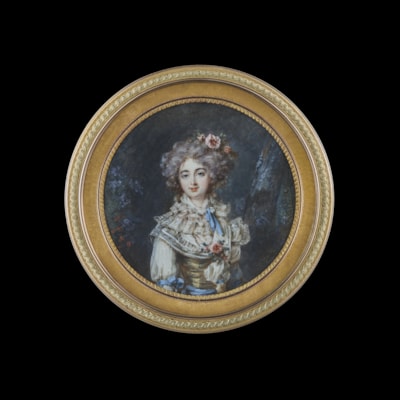JEREMIAH MEYER R.A.
(1735-1789)Portrait miniature of a Gentleman wearing a green coat, white waistcoat and jabot, his powdered hair worn en queue; circa 1775
Watercolour on ivory
Ivory licence number: GXPZHPZW
Gold frame, set with half pearls
Oval, 2 5/8 x 2 in. (67 x 51 mm)
£15,000
Meyer was born in Tübingen, Germany, the son of a portrait painter who brought him to England when he was 14 years old. Meyer studied at the St Martin’s Lane Academy, the drawing and painting school lead by William Hogarth (1697–1764) and considered the precursor to the Royal Academy. He became the pupil of Christian Friedrich Zincke (1683/4-1767), the great portrait enamellist of the previous generation, and subsequently worked in enamel in the early part of his career, producing a small number of extremely fine portrait enamels.
Meyer remained in England for the rest of his life, working mainly in London. In 1764 he became Miniature and Enamel Painter to King George III, as well as Miniature Painter to Queen Charlotte, but his association with the royal family predates this. Meyer is responsible for the miniature portrait of George that was sent to Charlotte as an engagement present in 1760, mounted in a pearl bracelet.[1] Prior to that, he is believed to have worked on the medal commemoration the majority of George as Prince of Wales, issued 4 June 1759.[2]
Meyer was a founder member of Royal Academy in 1768, exhibiting miniatures, enamels and watercolour drawings between 1769-83. He was included in Johan Zoffany’s (1733-1810) ‘The Academician of the Royal Academy’ (1771-72), which depicts many of the artists the king and queen had patronised.
This portrait miniature dates to the peak of Meyer’s career, when, having enjoyed royal patronage for over a decade, he was producing some of his most sophisticated miniatures. His work had evolved from smaller portraits, easily set in dainty jewellery, to the larger (closer to 3 inch) portraits that would become the norm in miniature painting, and of which this is an example. The larger-sized miniature allowed the artist to capture the florid and voluminous fashions of the day (hairstyles were increasing in height, while frills and flounces cast a wider, more detailed silhouette). The present sitter wears an eye-catching green coat typical of the palette associated with ‘macaroni’ style of the 1760s and 1770s.
This miniature was once owned by Walter Samuel, 2nd Viscount Bearsted (1882-1948), whose superb art collection was kept at Upton House, Warwickshire and given to the National Trust with the house on his death in 1948. A philanthropist and passionate patron of the arts, Bearstead was chairman of the trustees at the National Gallery a trustee of the Tate Gallery, a major benefactor of the Ashmolean Museum, Oxford, and chairman of the Whitechapel Art Gallery, London.
[1] Queen Charlotte is shown wearing the bracelet in portraits by Zoffany, Joshua Reynolds, Benjamin West, William Beechey and Thomas Lawrence.
[2] Walker, R., Miniatures in the Collection of Her Majesty The Queen; The Eighteenth and Early Nineteenth Century (Cambridge University Press), 1991, p.xv

shipping notice
Worldwide shipping is included in all prices.
The Limner Company does not accept any responsibility for import duty, this is to be paid by the buyer.
Some stock items contain materials from endangered species which are governed by CITES regulations and will require a permit to export outside of Great Britain. If a certificate of export is required then this will be the responsibility of and paid for by the buyer .
you may also like



 +44(0)7983510056
+44(0)7983510056











